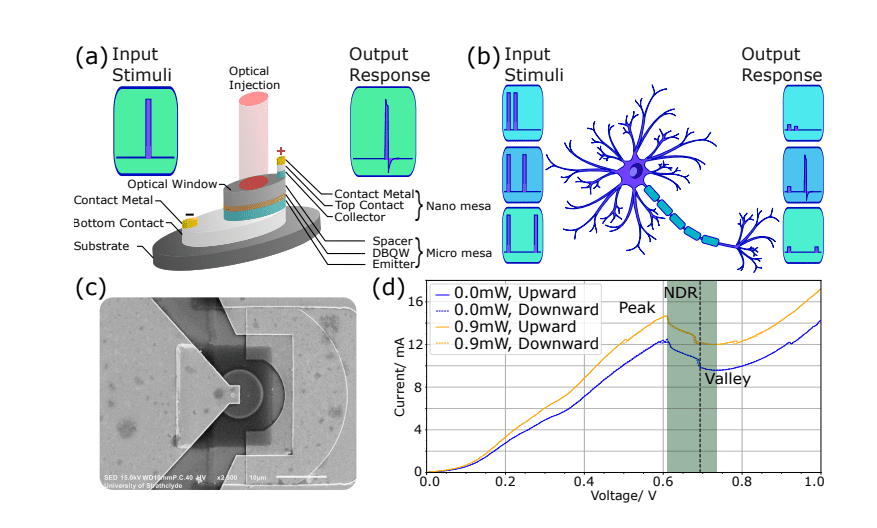Neuromorphic computing, which aims to mimic the brain’s efficiency, increasingly explores spiking neural networks as a powerful alternative to traditional computing architectures. Andrew Adair, Dafydd Owen-Newns, and Giovanni Donati, alongside colleagues from the University of Strathclyde and the University of Lisbon, have developed a novel photonic-electronic spiking neuron that significantly advances this field. Their research introduces a ‘resonate-and-fire’ neuron, capable of processing information encoded not just in the presence or absence of light pulses, but also in the precise timing between them. This innovation moves beyond simpler neuron models and unlocks the potential for ultrafast, energy-efficient temporal information processing, demonstrating key functionalities like spike-frequency filtering and pattern recognition with remarkably low power consumption, paving the way for advanced light-enabled computing systems.
Resonant Tunnel Diodes Enable Spiking Neural Networks
This research focuses on developing neuromorphic computing systems, specifically spiking neural networks, which aim to replicate the behaviour of biological neurons. These networks communicate using brief electrical pulses, or spikes, promising lower power consumption and increased efficiency for certain tasks. Central to this work are resonant tunnelling diodes, devices exhibiting negative differential resistance, making them ideal for creating fast, low-power spiking neurons and synapses. Vertical-cavity surface-emitting lasers are also key components, providing fast optical signalling for generating spikes and implementing synaptic connections.
The goal is to integrate these optical and electronic components to create more complex and efficient neuromorphic systems for applications such as processing time-varying signals, recognising temporal patterns, performing image and signal classification, and enabling visual odometry. The team designs artificial neurons and synapses that closely mimic realistic spiking behaviour, exploring neuron models including integrate-and-fire and resonate-and-fire neurons. Resonate-and-fire neurons are particularly important, as they exhibit resonance, a preferred frequency of stimulation, which allows for temporal processing and pattern recognition. Current research explores creating programmable optical synapses to connect the spiking circuits, and utilising chirp signals for communication within the network. Biomedical applications are also being investigated, with the analysis of brain activity as a possible future direction. This research pushes the boundaries of neuromorphic computing by leveraging the unique properties of resonant tunnelling diodes and vertical-cavity surface-emitting lasers to create fast, low-power, and programmable spiking neural networks capable of efficiently processing temporal information and performing complex tasks.
Optical Spiking Neuron with Resonant Tunnelling Diode
Scientists have engineered a novel photonic-electronic resonate-and-fire spiking neuron that closely mimics the complex dynamics of biological neurons. This breakthrough relies on a resonant tunnelling diode sensitive to light, enabling the device to generate excitable electrical spikes in response to nanosecond-duration, low-power infrared optical signals. The team fabricated a nanopillar with a 500nm diameter top contact and a 9μm diameter optical window, positioning a 250nm thick indium gallium arsenide spacer layer next to the diode’s double barrier quantum well to maximise light absorption. Detailed characterisation of the diode’s performance revealed a negative differential resistance region, crucial for the device’s oscillatory behaviour.
Impulse tests demonstrated that injecting sub-threshold optical pulses generates a voltage decay, allowing determination of the conditions necessary for resonant spiking. Experiments involving time- and wavelength-multiplexing techniques demonstrated the ability to process multiple optical inputs simultaneously using vertical-cavity surface-emitting lasers, enabling several neuromorphic processing tasks at nanosecond rates. The team also demonstrated a digital-to-spike encoding task, showcasing the potential of this light-sensitive neuron for advanced information processing. The experimental findings closely align with theoretical simulations, validating the design and confirming the potential of this approach for low-power, high-speed temporal information processing.
Fast Spiking Neuron Mimics Biological Signals
Scientists have developed a photonic-electronic spiking neuron that mimics the behaviour of biological neurons, achieving resonate-and-fire operation with nanosecond-scale speed. This new neuron responds to the timing of high-speed optical signals, utilising a light-sensitive resonant tunnelling diode to produce excitable spikes triggered by low-power infrared light. Experiments demonstrate precise control over the neuron’s dynamics through both the timing of optical pulses and applied bias voltage, enabling it to filter both analogue and digital inputs. The resonant tunnelling diode neuron incorporates a 500nm diameter top contact nanopillar with a 9μm diameter optical window, featuring a 250nm thick indium gallium arsenide spacer layer for efficient light absorption.
Measurements of the diode’s current-voltage characteristics reveal a self-oscillatory region, outlining its potential as an artificial spiking neuron. Impulse tests show that injecting sub-threshold optical pulses generates oscillatory decay, with a resonance period of 48 nanoseconds when biased at a specific voltage. Conversely, at a different bias, the decay is exponential, demonstrating an overdamped regime. Investigations into the neuron’s response to varying stimuli reveal a linear relationship between the amplitude of sub-threshold optical input pulses and the transient response in the output voltage. The resonance period was found to increase slightly as the optical pulse amplitude increased, and sweeping the bias voltage resulted in a corresponding increase in the resonance period, demonstrating a tuneable resonance frequency. These results establish a pathway towards low-power, high-speed temporal information processing for light-enabled applications.
Infrared Neuron Spikes at Nanosecond Rates
This work experimentally demonstrates, for the first time, a photonic-electronic resonate-and-fire spiking neuron, realised using an optically-sensitive resonant tunnelling diode operating at infrared wavelengths. The neuron exhibits all-or-nothing spiking responses at nanosecond rates, displaying oscillatory decay when stimulated with optical signals, a behaviour governed by the diode’s unique current-voltage characteristic. Theoretical analyses confirm strong agreement with experimental findings, validating the observed dynamics and providing a foundation for further development. The research team discovered that the neuron’s excitability and resonance period can be significantly increased through circuit optimisation, potentially reaching sub-nanosecond rates. Furthermore, the resonance period and damping of the neuron’s oscillations are tunable via applied bias voltage, establishing a mechanism for frequency-sensitive event-based spike encoding. Experiments demonstrate deterministic spike firing from sub-threshold optical pulses, contingent on precise inter-pulse timing within the neuron’s narrow resonance window, and successful multi-wavelength operation due to the diode’s wide absorption band.
👉 More information
🗞 Resonate-and-Fire Photonic-Electronic Spiking Neurons for Fast and Efficient Light-Enabled Neuromorphic Processing Systems
🧠 ArXiv: https://arxiv.org/abs/2510.14515

